
Solidago, commonly called goldenrods, is a genus of about 100 to 120 species of flowering plants in the family Asteraceae. Most are herbaceous perennial species found in open areas such as meadows, prairies, and savannas. They are mostly native to North America, including Mexico; a few species are native to South America and Eurasia. Some American species have also been introduced into Europe and other parts of the world.

Solidago nemoralis is a species of flowering plant in the family Asteraceae. It is native to North America, where it is widely found in Canada and the United States. Its common names include gray goldenrod, gray-stem goldenrod, old-field goldenrod, field goldenrod, prairie goldenrod, dwarf goldenrod, and dyersweed goldenrod.

Solidago altissima, the tall goldenrod or late goldenrod, is a North American species of goldenrod in the family Asteraceae which is widespread across much of Canada, the United States, and northern Mexico. It is common in much of its range and fairly tolerant of landscapes which have been disturbed by humans. It has become naturalized in many parts of the world.
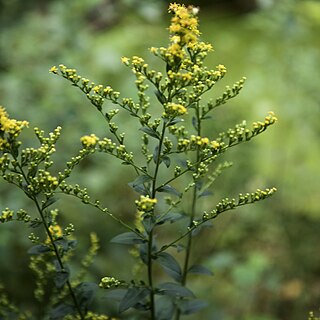
Solidago patula, the roundleaf goldenrod or rough-leaved goldenrod, is a species of goldenrod found in wetlands, especially swamps, fens, and sedge meadows. It is native to most of the eastern United States, as far west as Wisconsin and Texas. It is a perennial herb. There are two subspecies. It can grow up to 5 feet tall.

Solidago spectabilis is a species of goldenrod known by the common names Nevada goldenrod, basin goldenrod, and showy goldenrod. It is native to the western United States in the Great Basin and surrounding areas. It is found in California, Arizona, Nevada, Oregon, and Utah. There are historical records saying it once grew in southwestern Idaho, but is now extirpated there. This variety has also been seen in the western Montana county of Sanders.

Solidago houghtonii is a rare North American species of flowering plant in the family Asteraceae known as Houghton's goldenrod. It is native to southern Ontario, Canada and the northern United States. It is threatened by the loss and degradation of its habitat. It is a federally listed threatened species of the United States and it is designated a species of special concern by Canada's Committee on the Status of Endangered Wildlife in Canada.

Solidago missouriensis is a species of flowering plant in the family Asteraceae known by the common names Missouri goldenrod and prairie goldenrod. It is native to North America, where it is widespread across much of Canada, the United States, and northern Mexico. It grows from British Columbia east to Manitoba, south as far as Sonora, Coahuila, Texas, and Mississippi.

Solidago odora, the sweet goldenrod, anisescented goldenrod or fragrant goldenrod, is a North American species of goldenrod within the family Asteraceae. The plant is native to the United States and Mexico, found in every coastal state from Veracruz to New Hampshire and as far inland as Ohio, Missouri, and Oklahoma. It flowers from July through October.
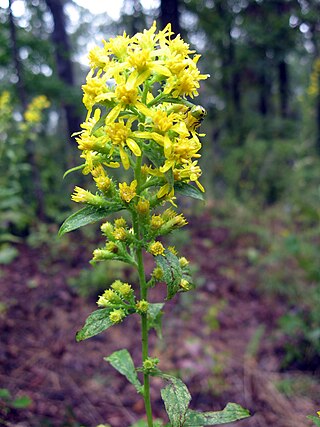
Solidago buckleyi, or Buckley's goldenrod, is a species of goldenrod native to central North America. It is an uncommon species with a small range, being found mainly in the Ozark Mountains of Arkansas and Missouri, and in the uplands near the confluence of the Ohio and Mississippi Rivers near southern Illinois and western Kentucky. There are also a few isolated populations reported from Indiana. Its preferred habitat is open oak woodlands.

Solidago velutina, the threenerve goldenrod or velvety goldenrod, is a plant species native to Mexico and to the western United States. The species has been found in southwestern Oregon, east to the Black Hills of South Dakota, and as far south as México State in the central part of the Republic of México. It is classified as a member of Subsection Nemorales.
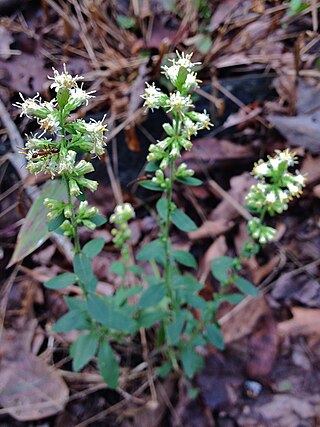
Solidago bicolor, with several common names including white goldenrod and silverrod, is a plant species native to much of eastern North America. It is found in Canada and in the United States. It prefers sandy and rocky soils, and can frequently be found along roadsides.

Solidago simplex, the Mt. Albert goldenrod or sticky goldenrod, is a North American plant species in the genus Solidago of the family Asteraceae. It is widespread across much of Canada, parts of the United States, and northeastern Mexico.
Solidago brachyphylla is a North American species of flowering plant in the family Asteraceae known by the common name Dixie goldenrod. It is native to the southeastern United States, from southern Mississippi to the Carolinas.

Solidago curtisii, commonly called Curtis' goldenrod and mountain decumbent goldenrod, is a North American species of flowering plants in the family Asteraceae. It is the eastern part of the United States from Pennsylvania to Mississippi and Alabama, primarily in the southern Appalachian Mountains.

Solidago drummondii, commonly called Drummond's goldenrod, is a North American species of flowering plants in the family Asteraceae. It is native to the middle Mississippi Valley of the Central United States, primarily in Missouri and Arkansas but with additional populations in Louisiana and Illinois.

Solidago erecta is a species of goldenrod known by the common names showy goldenrod and slender goldenrod. It is native to the eastern United States, from Massachusetts west to Indiana, and south as far as Georgia and Mississippi.

Solidago sphacelata, commonly known as false goldenrod or autumn goldenrod, is a North American species of goldenrod in the family Asteraceae. It is native to the eastern United States from Virginia and the Carolinas west as far as Illinois and Mississippi.
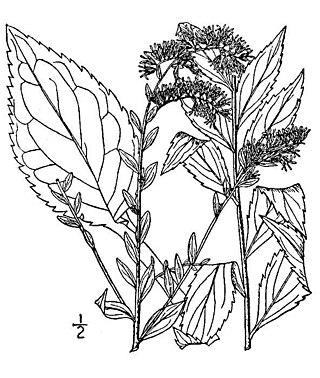
Solidago ulmifolia, commonly known as elmleaf goldenrod, is a North American species of goldenrod in the family Asteraceae. It is found in Canada and the eastern and central United States.

Solidago wrightii, commonly known as Wright's goldenrod, is a North American species of goldenrod in the family Asteraceae. It grows in northern Mexico and the southwestern United States.
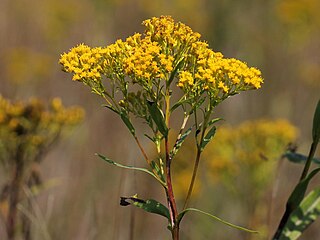
Solidago sect. Ptarmicoidei is a section of flowering plants in the genus Solidago. They are sometimes considered a separate genus: Oligoneuron. Like related species they are known as goldenrods. This section contains seven species of perennial herbs, all native to North America. They are distinguished from other goldenrods by their corymbiform flowerheads, which are flat or rounded in profile and about as broad as tall or broader, for which they are sometimes called flat-topped goldenrods.




















